

There are more than 500 species of crayfish found throughout the world.
Most species live in freshwater, though a few species can live in salt water.
They are usually about 3" long (8 cm) and look a lot like shrimp with a head, thorax and jointed abdomen. Most are colored to blend into their habitats. They have two pairs of antennae and eyes on stalks that move. They have 1 pair of large front claws, 4 pairs of walking legs attached to the thorax, and five pairs of swimmerets (under their abdomen). All of their legs grow back if they are lost. They have a fan-shaped tail.
They hide under rocks or stream debris and come out at night (nocturnal) to search for food. They creep along the bottom on the stream. If startled, they shoot backward with a sudden flap of their tail. They will pinch with front claws.
They eat snails, fish eggs, algae, insects, larvae, worms, tadpoles, dead fish and other dead debris.
The females carry up to 800 fertilized eggs under their swimmerets on the underside of their abdomen. The sac of eggs looks like a berry. After they hatch, babies will stay attached to their mother until they grow large enough to survive on their own, shortly after their second molt.
Domain: Eukarya
Kingdom: Animalia
Phylum: Arthropoda
Subphylum: Crustacea
Class: Malacostraca
Order: Decapoda
Family: Cambaridae
Genus: Procambarus
Subgenus: Girardiella
Species: P. nigrocinctus
When you research information you must cite the reference. Citing for websites is different from citing from books, magazines and periodicals. The style of citing shown here is from the MLA Style Citations (Modern Language Association).
When citing a WEBSITE the general format is as follows.
Author Last Name, First Name(s). "Title: Subtitle of Part of Web Page, if appropriate." Title: Subtitle: Section of Page if appropriate. Sponsoring/Publishing Agency, If Given. Additional significant descriptive information. Date of Electronic Publication or other Date, such as Last Updated. Day Month Year of access < URL >.
Amsel, Sheri. "Crayfish" Exploring Nature Educational Resource ©2005-2024. December 16, 2024
< http://www.exploringnature.org/db/view/545 >

